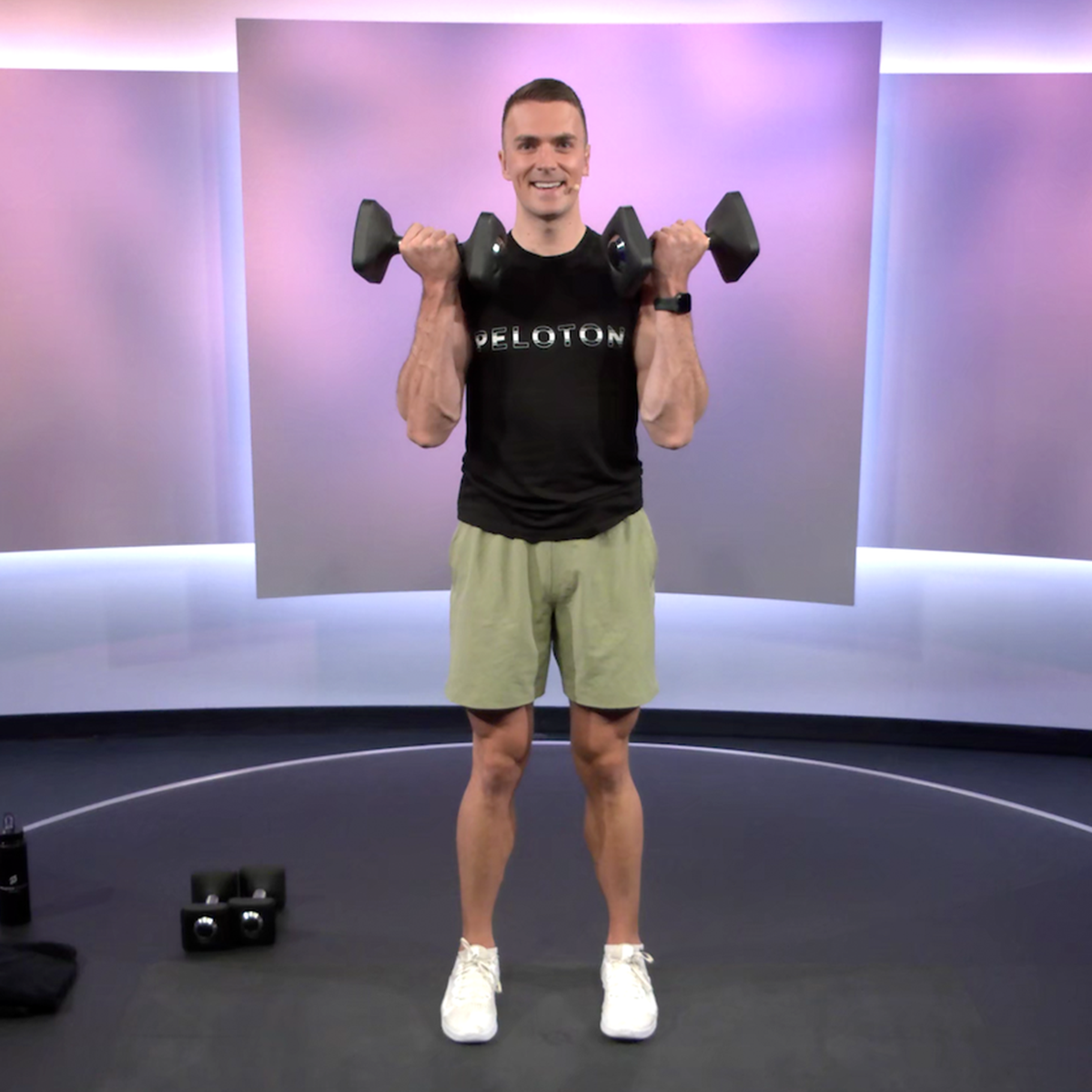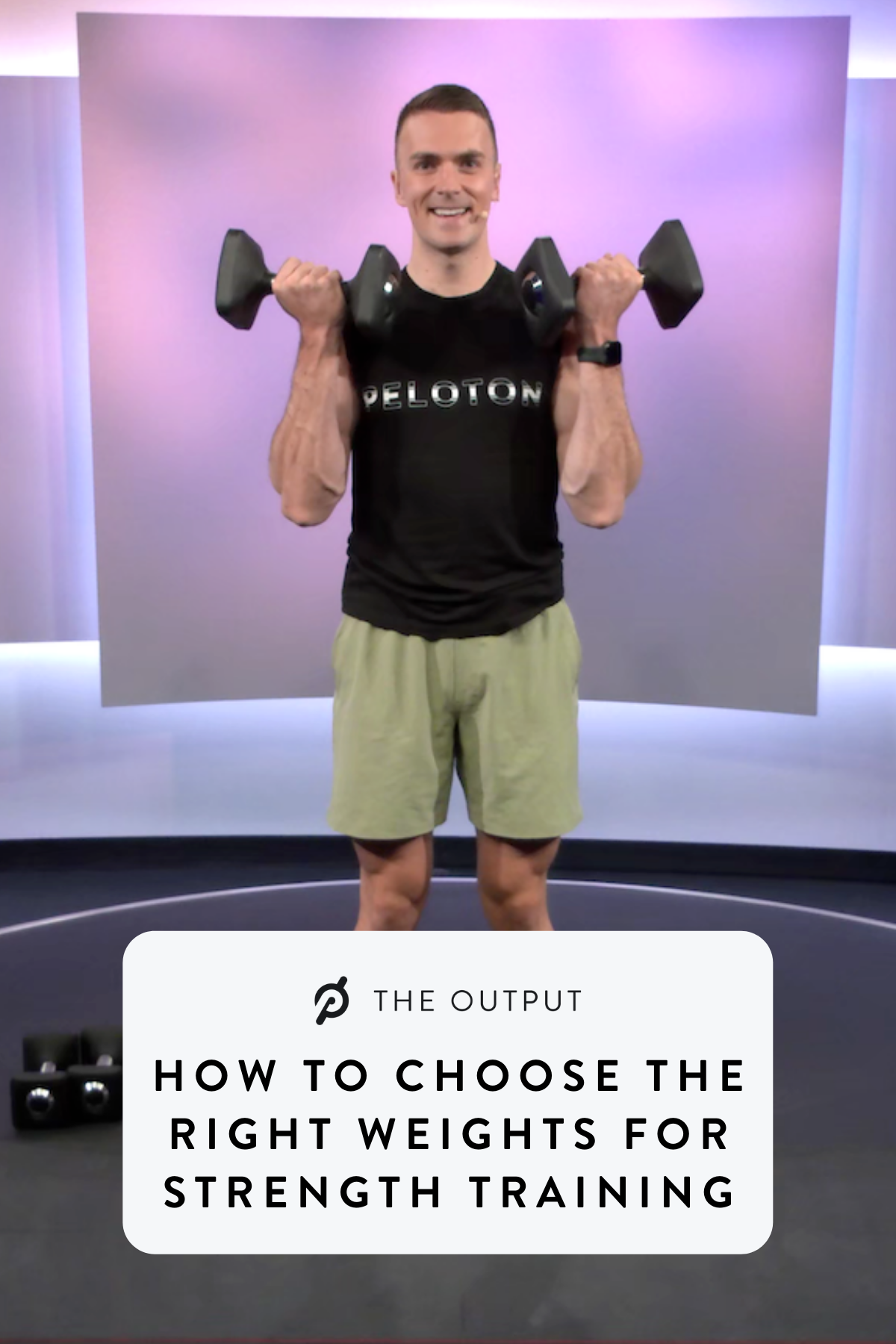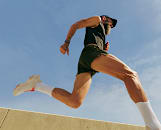
We’ve Cracked the Code to Choosing the Right Weights for Strength Training
“Light” and “heavy” mean different things depending on your abilities and goals.
By Alyssa Sybertz, Team Peloton•
Set Your Fitness Goals
How to Know How Much Weight to Lift
Consider Your Background and the Muscles You’re Working
How Do You Know You’re Lifting the Right Weights?
Prioritize Form
Exercise routines that utilize weights, such as strength training and bootcamp classes, are a smart addition to any workout repertoire. But without the help of a personal trainer, you might be at a loss for exactly how to incorporate weights into your workouts. Should you lift light and get more reps in? Or lift so heavy you’re struggling through each set? Does it make a difference whether you’re working your upper body or lower body that day, or whether you’re a runner vs. a yogi?
Discover more ways to reach your goals with Peloton
As with so many other things in fitness, the answer to “what weight should I be lifting” is a gray area. The weights you reach for depend on your goals, your preferences, and your physical abilities.
Confused about which dumbbells to use? We asked Peloton instructor Ben Alldis to share his strength training expertise to help you learn how to know how much weight to lift.
Set Your Fitness Goals
Selecting the right dumbbell weight is a crucial part of your workout, so you’ll want to consider it carefully. “Different exercises, skill levels, and physical abilities will necessitate different dumbbells,” Ben says. Translation: One set of eight-pound weights won’t give your body the variety and challenge it craves.
Start by considering your fitness goals, he advises. “Are you trying to develop a single muscle group? Gain stamina? Or perform each exercise with better form? Setting your goals will guide your dumbbell selection process.” Here’s a quick look at how those goals might break down:
Improve Fitness
If you’re new to working out, your goal might be as simple as getting comfortable with strength training and perfecting your form for various exercises. If that’s you, lighter weights will help you gain confidence and nail your form (which will be a crucial foundation for getting those gains later on).
Using light weights can also be useful if you’re recovering from an injury or doing physical therapy, notes Ben. That’s because lighter weights (and higher reps) can stabilize muscles to support your tendons and joints.
Build Stamina
If you want to build stamina (aka the time an activity can be performed at your max effort), consider choosing a moderately challenging weight. In this case, a “moderate challenge” means that in a set of 12 reps, you’re struggling to get through the last three reps.
Increase Muscle Mass
And if you’re ready to bulk up, you guessed it—reach for those heavies. “Heavier dumbbells are good for building muscle” in route to hypertrophy (the scientific term for increased muscle size through exercise), explains Ben.
How to Know How Much Weight to Lift
Now that you have your fitness goals set, it’s time to get specific about starting points. Remember, these weights are just suggestions; you can always go lighter or heavier based on your body’s ability.
On a similar note, the weights you start with are totally unique to your fitness journey, and they may vary wildly from the weights your friends, family, or fellow gym-goers use when strength training. Instead of getting caught up in the comparison trap, focus on what your body is capable of and how strength training improves your overall health and well-being.
Light vs. Medium vs. Heavy Weights
For beginners, Ben recommends trying five to 10 pounds for light weights, 10 to 20 pounds for medium weights, and 15 to 30 pounds for heavy weights—or simply starting with five-pound weights for each exercise and working up from there. He also recommends having two- or three-pound weights on hand for some arm exercises. (Pro tip: these are perfect for Arms & Light Weights classes on the Peloton App. They may only be ten minutes, but you’ll definitely feel the burn.)
On the other hand, if you’re more advanced, you can start a little bit heavier. As a reference point, Ben uses 15- and 25-pound weights for both full-body and arms and shoulders classes, and 20- and 30-pound weights for glutes and legs workouts.
Consider Your Background and the Muscles You’re Working
If you’re working out at home, you likely don’t have a swath of different dumbbells to try out and may only have the space or budget for a few weight options. In this case, Ben suggests considering your personal background with fitness.
“If you’re someone who has experience in exercise and sports, or you work a job which requires you to carry out manual labor, you are likely to be stronger than someone who doesn't,” he says, stressing the fact that each person’s starting point is going to be unique. If that’s the case for you, take the opportunity to challenge yourself and prioritize slightly heavier weights when building your home gym.
And whether you’re working out at home or in a gym, you should also think about which class you’re planning to take when deciding how much weight you should be lifting. “The weight you use should correspond to the strength of the muscles you're working,” Ben says. “For example, your glutes are very powerful, so you can probably go pretty heavy with a weighted squat or deadlift. However, if you’re working your shoulders with a lateral or frontal raise, you may need to go lighter because it’s a smaller, weaker muscle group.”
A good rule of thumb: Ben generally recommends using lighter weights for your biceps, triceps, and deltoids and heavier weights for your chest, legs, and back.
How Do You Know You’re Lifting the Right Weights?
Ah, the eternal question. Luckily, there’s a simple way to know if your chosen weights fit your goals as perfectly as Cinderella’s glass slipper fit her foot. Here’s the secret: The last couple repetitions of each set will clue you into if you’re using the correct weights, Ben says.
“Your weight is too light if you don't start to struggle during those last few reps,” he explains. “You should start to feel the work from the very first rep, and your weights should really make you work for those last few, without compromising your form. If you feel like you have no problem getting to the end, it's probably too light.”
How to Know When to Switch Your Weights
We get it: You might get comfortable banging out biceps curls with 10-pound reps, feeling totally confident that you’ll get through each set and not be sore the day after a workout. Unfortunately, growth never happens in your comfort zone—and being mindful of your effort will help you progress toward your fitness goals. In fact, feeling the work and changing your weights up when they start to feel easy is critical to achieving results.
“By changing or progressing in your workouts, you'll keep your muscles challenged, and you'll get stronger,” Ben says. “In the beginning, you want to progress in range of motion and form. If you do the same workout you did the week before, but with better form, that’s progression. After proper form and full range of motion are established and ingrained, it’s time to worry about progressing in repetitions and weight.”
On the other end of the spectrum, there might be times when you need to drop to a lower weight in order to keep your goals in motion. We know, it sounds contradictory. However, progress isn’t always linear, and sometimes when life happens (an injury, a long vacation, or just needing to prioritize other things in a season of life), your body needs to take a step back before you can move forward. Some signs that you might need to grab lighter weights for a bit may include: you burn out much more quickly during reps and sets, your form starts to suffer, or you find yourself debilitatingly sore after a workout you used to completely easily.
Prioritize Form
Speaking of form… “Without a doubt, lifting lighter weights with proper form is always better than lifting heavier weights with poor form,” Ben says, because poor form can lead to injury, including strains, sprains, tears, and breakages of muscles, ligaments, bones, and joints. For this reason, Ben recommends mastering each exercise using only your bodyweight before even picking up dumbbells. “When you feel confident that your form is strong using your own bodyweight, select light weights and build from here,” he says. “It’s always better to start light and add weight in small increments.”
Ready to put your dumbbells choices to the test? Join Ben in a strength class on the Peloton App today!

Peloton App
Access thousands of classes with no equipment needed.

This content is for informational and educational purposes only and does not constitute individualized advice. It is not intended to replace professional medical evaluation, diagnosis, or treatment. Seek the advice of your physician for questions you may have regarding your health or a medical condition. If you are having a medical emergency, call your physician or 911 immediately.
Level up your inbox.
Subscribe for a weekly dose of fitness, plus the latest promos, launches, and events.
By providing your email address, you agree to receive marketing communications from Peloton.
For more about how we use your information, see our Privacy Policy.





